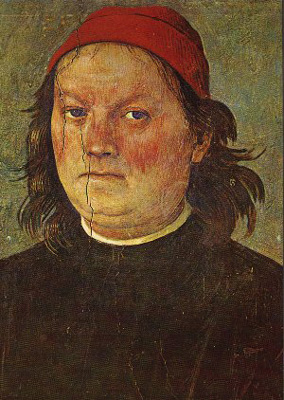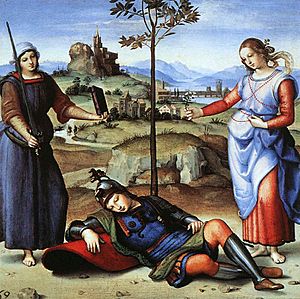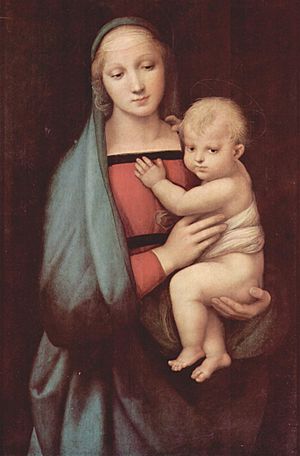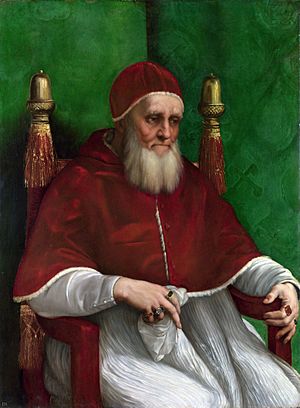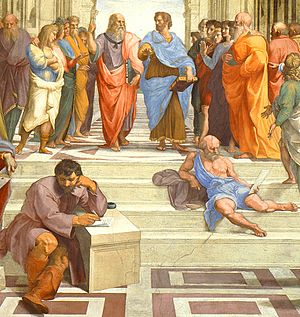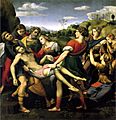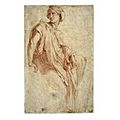Raphael facts for kids
Quick facts for kids
Raphael
|
|
|---|---|
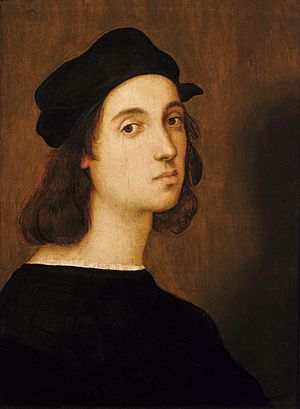
Self-portrait by Raphael
|
|
| Born |
Raffaello Santi (or Sanzio)
March 28 or April 6, 1483 Urbino, Duchy of Urbino
|
| Died | April 6, 1520 (aged 37) |
| Resting place | The Pantheon, Rome |
| Known for | |
| Movement | Renaissance |
Raffaello Sanzio, usually known as Raphael (April 6, 1483 - April 6, 1520), was a Renaissance painter and architect. He, along with Leonardo da Vinci and Michelangelo, is considered one of the three greatest painters of the High Renaissance.
He is best known for his paintings of the Madonna and Christ Child and for his paintings in the Vatican in Rome, Italy.
Contents
Perugia
Raphael was born in Urbino, in the region of Umbria, Italy. He was the son of Giovanni Santi (d. 1494), who was also a painter, and Magia di Battista Ciarla (d. 1491). Raphael's father was his first teacher, but he died when Raphael was only eleven.
When he was about 15, Raphael became an apprentice at the workshop of the painter Pietro Perugino. Perugino was known by that name because he was the most famous painter in the town of Perugia. Perugino was famous not only in Umbria but also in Rome and in Florence, the home of Leonardo and Michelangelo. He had been one of the artists given the important job of painting the Pope's large chapel in the Vatican, the Sistine Chapel.
Perugino was known to have expert ways of painting (technique) and was good at finishing paintings on time. This made him popular with his patrons. He painted some portraits of people alive in his day, but most of his pictures are of religious figures of the past. Some of his paintings are small pictures of the Madonna and Child that could be used in a family chapel for private worship. Because he was famous, Perugino also got lots of work from wealthy patrons and churches, so he painted many very large pieces to go above the altars in churches. To do this, he needed the help of his apprentices.
Raphael was able to learn a great deal from Perugino - drawing, the anatomy of the human figure, paint chemistry, and the technique of putting the paint onto the picture in smooth layers. The people in Perugino's paintings often have sweet, gentle faces. Many of Raphael's paintings are also sweet and gentle. Some painters, such as Leonardo, were quick to change their style and make their paintings show their own touch. But Raphael continued to paint in the style that Perugino had taught him. He added new ideas that he learned by looking at the work of other artists. Raphael is famous simply because he excelled at painting and because people loved his paintings so much.
Early Paintings
The painting that is thought to be his earliest known work is a small picture called The Vision of a Knight. It is considered to be an allegorical painting. In this painting, a knight lies asleep. In his dream, there are two beautiful women. One woman, dressed in soft, flowing clothes, offers him flowers. The other woman, dressed in dark clothing, offers the knight a sword and a book. The path behind the woman in soft, flowing clothes runs beside a river. The other path leads up a steep mountain. In this painting, Raphael was thinking about choices. Should the knight take the road to duty or the road to love?
Other early pictures by Raphael are Three Graces and Saint Michael.
Raphael's first major work was The Marriage of the Virgin, which was painted in 1504. It was influenced by Perugino's painting for the Sistine Chapel of Jesus giving the Keys to Saint Peter. It is now in the Brera Gallery in Milan, Italy.
Florence
In about 1504, Raphael traveled with another painter, Pinturicchio, to Florence, Italy. Florence was famous for its artworks, its artist's workshops, its new Renaissance buildings, and its huge cathedral. Raphael wanted to see the work of Michelangelo, Leonardo da Vinci, and other important painters and sculptors.
The Madonnas
Florence had a very strong tradition of creating images of the Madonna and Child because the city was dedicated to the Blessed Virgin Mary. On almost every street corner there was a painting or a brightly-colored statue of the Madonna and Child.
While he was in Florence, Raphael painted many of his famous Madonna paintings. The most famous of these paintings are:
- The Madonna of the Goldfinch (c. 1505), which is now in the Uffizi Gallery in Florence, Italy;
- the Madonna del Prato (c. 1505), which is in the Kunsthistorisches Museum, in Vienna, Austria;
- the Esterházy Madonna (c. 1505 – 07, which is in Museum of Fine Arts, Budapest, Hungary; and
- La Belle Jardinière (The Madonna of the Beautiful Garden) (c. 1507), which is in the Louvre Museum, in Paris, France.
Rome
In 1508, Raphael was called to Rome by Pope Julius II. He became so popular while he was in Rome that he was known as the "Prince of Painters." He spent the last 12 years of his life in Rome and created many of his most famous paintings there.
While he was in Rome, Raphael was commissioned (given a job), to paint a fresco of the prophet Isaiah in the Church of Sant'Agostino. While he was working on the painting, he went to visit his friend, the architect, Donato Bramante. Bramante was at the Vatican while Michelangelo was painting the Sistine Chapel ceiling. Of course, Raphael wanted to see what the famous master was doing. While Michelangelo was away, Bramante took Raphael into the Chapel. When Raphael saw the way that Michelangelo had painted the prophets, he was so excited that he went back to Sant'Agostino's Church, scraped his painting of the prophet Isaiah off the wall, and started all over again. It is easy to see that Raphael's painting is in the style of Michelangelo. Raphael was not ashamed of this. He did it to give honor to the great master.
The Stanze
Among Raphael's most famous paintings are the frescos that are painted on the walls of Julius II's own rooms in the Vatican Palace, known as the Stanze. The paintings in the Stanza della Segnatura and the Stanza d'Eliodoro were created by Raphael himself, while the Stanza dell'Incendio was designed by Raphael and painted by his assistants.
The School of Athens is the most famous fresco in the Stanze della Segnatura. It shows a group of learned people from Ancient Greece: philosophers, poets, dramatists, mathematicians, and others. They are listening to the central figure, who is the philosopher, Plato. The painting is meant to show that at that time, the early 1500s, there was a new birth of ideas and learning among the people of Rome that was equal to the learning of Ancient Athens.
To make this message clear, Raphael used the faces of the people that he knew. Michelangelo, with his broken nose, is thought to be sitting with paper and ink while resting his cheek on his hand. The tall figure of Plato with long hair and a flowing beard is a portrait of Leonardo da Vinci. He even included himself in the painting, standing near the back on the right side.
One of the excellent things about this painting is the way that Raphael painted the building in which the figures are standing. The architecture looks as if it is opening up from the real room.
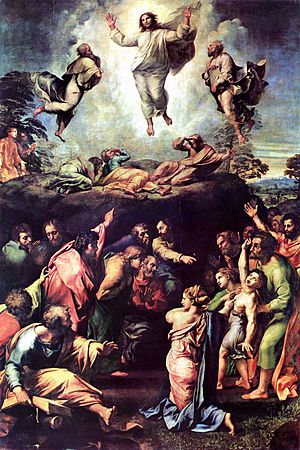
Architecture
In the 1500s, painters were often asked to design architecture. Raphael's first work as an architect was the funeral chapel in the church of Santa Maria del Popolo. Pope Leo X also chose Raphael to help design Saint Peter's Basilica alongside Donato Bramante. After Bramante died, Raphael took over the design of the basilica and changed its groundplan from a Greek Cross to a Latin Cross. Michelangelo went back to Bramante's plan but made it simpler. Then another architect, Maderna, made the building longer, as Raphael had planned.
The Transfiguration
Raphael's last work of art was a painting of the Transfiguration. This was an altarpiece, but Raphael died before he could complete it. It was instead finished by Giulio Romano, who was one of Raphael's assistants.
Death
Raphael died on his 37th birthday and was buried in the Pantheon in Rome. His funeral mass was celebrated at the Vatican and his Transfiguration altarpiece was put at the head of Raphael's funeral carriage.
Raphael quotes
- "When one is painting, one does not think."
- "There's only one thing that matters: Customer Satisfaction."
- "Time is a vindictive bandit to steal the beauty of our former selves."
Interesting Facts About Raphael
- Raphael had a difficult childhood: his mother died when he was nine, his father died when he was eleven, and his siblings died when they were young.
- Raphael became one of his town's best painters.
- He competed with two other famous artists (Leonardo Da Vinci and Michelangelo) while he was working in Rome.
- Raphael was engaged to be married, but never married his fiancé.
- Raphael was considered one of the most important architects in Rome.
- He was charming. It is believed that he beat other artists for work because of his friendliness and outgoing personality.
- When planning his larger works, he drew many sketches and drawings.
Other pages
Images for kids
-
Guidobaldo da Montefeltro, Duke of Urbino from 1482–1508, c.1507
-
The Madonna of the Pinks, c. 1506–7, National Gallery, London
-
The Miraculous Draught of Fishes, 1515, one of the seven remaining Raphael Cartoons for tapestries for the Sistine Chapel
-
Raphael and Maria Bibbiena's tomb in the Pantheon. The Madonna is by Lorenzetto.
-
The Mond Crucifixion, 1502–3, very much in the style of Perugino
-
Self-portrait, Raphael in the background, from The School of Athens
See also
 In Spanish: Rafael Sanzio para niños
In Spanish: Rafael Sanzio para niños


